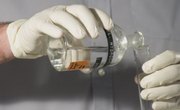
Millions of people use household products every day for cleaning, beauty regimes, food preparation and medicinal purposes. These are so common and accessible, most consumers don't even think about the substances that make up the products. A check of the periodic table of elements reveals interesting information about these things we take for granted every day.
Magnesium
Atomic number 12 belongs to magnesium, which occurs naturally in chlorophyll as sunlight is converted into sugars by plants. It is a whitish metal, stable in the air, but reactive to boiling water. Once used as a component of photography and theater lighting, it is now used in alloys to provide strength to objects without adding mass. Compounds of magnesium are used to make household products such as dyes, medicine, cement and in the manufacturing processes of cotton products.
Carbon
Carbon is atomic number 6, and has two common crystalline forms. One form produces diamonds, the hardest substance known. This happens when the atoms are symmetrically arranged. They very rarely react with chemicals. The second form, graphite, is often used in lead pencils. It is a soft, conductive substance that is formed when the atoms are layered. There is also a non-crystalline form of carbon in charcoal, and carbon and iron alloys produce steel.
Nickel
Atomic number 28 indicates nickel, a lustrous silver metal with a slight golden hue. The element is rumored to be named for a mythological creature, who medieval German copper miners blamed for a lack of copper ore in their extractions. Nickel is strong and thus is used in household products such as:
- cookware
- cutlery
- sinks
- flatware
- cooking utensils
- faucets
Many kinds of jewelry are made from nickel-silver, a nickel-copper-zinc alloy.
Sodium
The metallic element sodium is atomic number 11, and it is essential for human and animal life. The lustrous silver metal is a component of electrolytes, and makes possible the transmission of nerve impulses in the body. Sodium is readily found in common table salt, and is used in oral rehydration drinks and baking soda. It is also the substance found in most fire extinguishers. Sodium compounds are used in soap, paper and glass manufacturing.
Silver
Atomic number 47 is silver, a metallic element that has been used for thousands of years. Silver mines produce the white metal, which in its purest form is soft and pliable. Common household products containing silver are mirrors, jewelry, coins and flatware, and it is used as a conductor in electrical work. It is also found in some antibacterial products and antibiotic medicines, as well as silver-cadmium batteries.
References
About the Author
Based in Jonesboro, Ark., Tanna Long began writing in 2007. Her articles regarding pet health and owner responsibility have appeared in "Bully" magazine. Long attended Arkansas State University and Arkansas Northeastern College, where she received an invitation to join Gamma Beta Phi Honor Society.
Photo Credits
Jupiterimages/BananaStock/Getty Images
